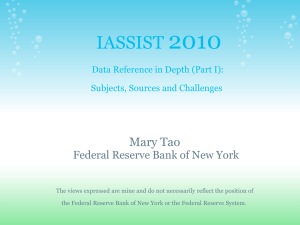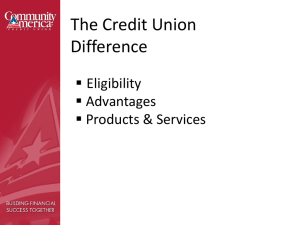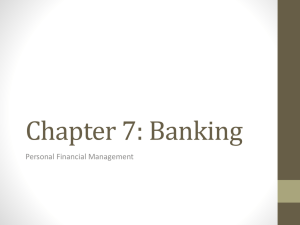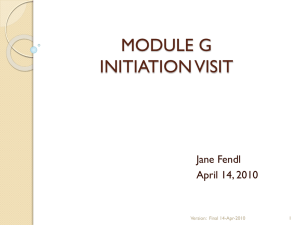Loan Securitization Basics
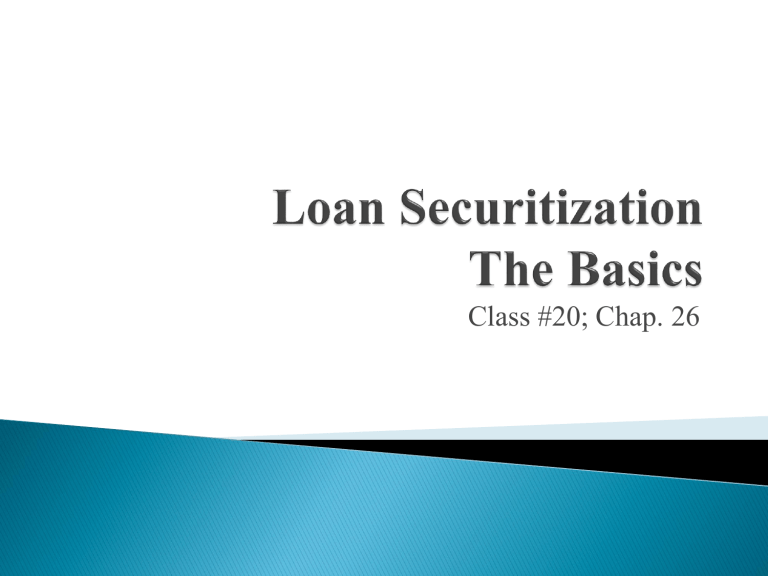
Class #20; Chap. 26
Purpose: Gain a basic understanding of what securitization is, why it exists and who the big players are.
Introduction
How assets are securitized (SPV or SIV)
Pass-through security
Who are the main players in securitization
What can be securitized
Costs and benefits of securitization
2
3
Securitization:
◦
Package loans or other assets into a pool of assets
◦
Sell securities backed by the pool of assets
Basics
1.
Package assets – Almost any type of asset can be securitized (mortgages, credit card loans, student loans …)
2.
Create a conduit, a subsidiary, sell the packaged assets to the subsidiary (SPV, SIV) – assets go off balance sheet
3.
The subsidiary finances the purchase of assets by issuing debt or assets backed by the pool.
4
How Are Assets Securitized?
5
1.
Through a Special Purpose Vehicle (SPV) - Bank creates a SPV and sells it a bundle of assets, which removes them from its balance sheet
2.
Through a Structured Investment Vehicle (SIV) -
Bank creates a SIV and sells it a bundle of assets, which removes them from its balance sheet
6
Securitization through a Special
Purpose Vehicle (SPV)
7
Bank
Creates SPV
SPV
SPV repackages assets
New Assets
New asset
(bonds) sold to investors
Investors
SPV pays bank for mortgages
Investors purchase securities and pay SPV an initial sum
Why does the bank go through all that trouble?
To remove assets from its balance sheet
Allows them to free-up regulatory capital (tax)
Pension Funds and
Insurance Companies
8
The SPV create securities based on the pool of assets
The pass-through is one type of securitization
Loan pool
Principal
$ $ $
Interest
SPV Asset Backed
Securities
CDO
CMO
CLO
RMBS
Pass Through
SPV:
1.
Collects fees for creating and servicing the Asset Backed Security (ABS)
2.
The SPV exists until cash flows from the assets are fully distributed
9
1.
2.
3.
4.
5.
6.
Bank Creates SPV
Bank sells SPV loans – removing them from the
Balance-sheet
SPV repackages loans into pass-through securities
Pass-through securities are sold to investors – pension funds and insurance companies
SPV pays bank for loans
SPV collects origination and servicing fees for the asset-backed security
10
Securitization through a Structured
Investment Vehicle (SIV)
11
Bank SIV
Creates SIV
Payment for mortgages
Profits = –
Mortgages
Rate on
ABCP
+ Fee income
Receive Payment $$
Commercial
Paper Market
Asset Backed Commercial
Paper (ABCP)
Commercial paper is secured by loans
11
1.
2.
Bank creates SIV
Bank Sells SIV assets (loans) – removes assets (loans) from its balance-sheet
3.
SIV offers an issue of commercial paper to finance the purchase of assets
4.
5.
Commercial paper is backed by the purchased assets making it asset backed commercial paper (ABCP)
SIV pays bank using the proceeds from commercial paper
13
Interest rate risk:
◦
SPV issues pass-through securities – payments to investors are based on cash flows from the pool so SPV is not subject to interest rate risk
◦
SIV issues commercial paper so their profits depend on the difference between the commercial paper rate and the mortgage rate (interest rate risk)
Profits:
◦
SPV earns profits from fees on originating and servicing the ABS
◦
SIV earns fees as well as the spread between CP and mortgage rates
Financing:
◦
SPV issues pass-through or asset backed securities
◦
SIV issues commercial paper (ABCP)
14
Pass-Through Securities
15
Pass-Through
Asset Backed
Security
The SPV create securities based on the pool of assets
The pass-through is one type of securitization
Loan pool
Principal
$ $ $
Interest
SPV
Investors
25% Share
75% Share
Question – who owns the loans?
16
FI builds a pool of mortgages and sells interest in the pool as pass-through securities
Pass-through securities represent a fraction of ownership in the pool
◦ e.g. a 1% share in the principal and interest payments of the pool
The originator of the pass-through collects payments from the pool and passes them through to the bond holders
Investors have direct ownership in this portfolio of mortgage loans or other securitized assets.
Ownership of loans rests with certificate holders (investors) and pass-throughs don’t appear on the originating bank’s B/S.
17
Who Securitizes Assets
&
Which Assets?
18
1.
Financial Institutions – Banks
◦
Usually securitize riskier assets
◦
Securitizations are usually more complicated: RMBS CDO
CMO …
2.
Government Sponsored Enterprise (GSEs)
◦
Securitize less risky home mortgages
◦
Usually more simple assets: Pass-through
Why do we have the GSEs?
19
Created to increase mortgage lending by facilitating securitization
FNMA
– Fannie Mae (Federal National Mortgage Agency)
FHLMC – Freddie Mac (Federal Home Loan Mortgage Corp)
GNMA
– Ginnie Mae (Government National Mortgage
Association)
20
Founded 1938, oldest of the three Mortgage Backed Securities
(MBS) sponsors – publicly traded (owned by share holders)
Main Functions
◦
Purchases loans and creates pass-through securities
◦
Sells MBS to outside investors
Swaps – engages in swap transactions swapping mortgages for
MBS with the mortgage originator
Securitizes conventional loans as well as government insured loans
◦
Conventional loans must have the proper loan-to-value ratio normally not to exceed 80%
◦
Charter
21
Public (stock holder owned) corporation founded in 1970
Performs similar tasks as FNMA
◦
Purchases loans from FIs
◦
Sells MBS
◦
Swaps MBS for loans
Charter
22
Main Difference between FHLMC and FNMA
◦
Originally FHLMC dealt mainly with savings banks
◦
Originally FNMA dealt mainly with mortgage bankers
◦
Now they are pretty much the same – competition promotes capitalism
Where are they now?
http://www.foxbusiness.com/economypolicy/2014/10/20/frannie-freddie-to-ease-creditrequirements/
23
Founded in 1968 after splitting from FNMA
Ginnie Mae does not buy or sell loans or issue mortgage-backed securities (MBS)
Main Functions
◦
Sponsoring mortgage backed securities programs by FIs – banks, thrifts,
& Mortgages Banks
◦
Provides guarantees to investors in Mortgage backed securities for timely payments
Has strict requirements for mortgages in the pool-
◦
Each mortgage must be, and must remain, insured or guaranteed by a federal agency FHA, VA, RHS or PIH.
◦
Mortgage insurance makes the lender whole if the borrower defaults
24
25
Home Mortgages: MBSs (Mortgage Backed Securities)
◦
Sub prime
◦
Conventional
Credit Cards: CARDs (certificates for amortizing revolving debts)
Auto Loans: CARs (certificates for automobile receivables)
Small Business Loans guaranteed by the Small Business
Administration
Commercial and Industrial Loans: CLOs (Collateralized Loan
Obligations)
Can all assets be securitized?
26
Costs and Benefits of
Securitization for Banks
&
Risks Faced by Investors
27
Main Coast: Increase off-balance sheet risk exposure
SIV:
◦
The sponsoring bank guarantees the issue.
1.
How?
How can the SIV issue high-quality CP?
2.
Bank can sell the loans with recourse
◦ In either case, the guarantee increases the banks’ off-balance sheet risk
◦
If the SIV defaults, the bank assumes responsibility for the issue or takes possession of the bad loans
How would this affect a bank’s capital adequacy?
SPV: There is really no risk to the bank with an SPV
◦
Pass-through payments are based on the cash flows of the pool
◦
If mortgages go bad the investors receive lower payments. The SPV is not in danger of defaulting on its obligated payments
SIV seems more risky why not just use the SPV?
28
1.
Reduces Regulatory tax
◦
Banks face substantial regulatory costs for holding risky assets on their balance sheet
◦
Banks can avoid these regulatory costs by securitizing risky assets
2.
Reduces Gap exposure (refinancing risk)
◦
Mortgages are financing using short-term debt which must be refinanced.
That rate will change but the mortgage interest rate will remain constant
3.
Illiquidity Risk
◦
Mortgages are illiquid and will likely need to be sold at a large discount
◦
Securitizations are more liquid so they can usually be sold at less of a discount.
29
1.
◦
◦
◦
Default Risk
If the mortgage pool is not insured, bond holders will loose principal and interest if mortgagees default on their loans.
If the SPV/SIV payments are not insured, then bond holders may loose principal and interest if the SPV defaults.
GNMA bonds are not exposed to default risk !
2.
Prepayment risk (discussed in next section)
◦
Bond holders will likely lose interest income on prepaid principal
3.
Interest rate risk
◦
Just like a treasury bond, the price of bonds generated through securitization are sensitive to changes in interest rates.
30
1.
Bank Creates SPV/SIV
2.
Bank Sells Assets to SPV/SIV
3.
SPV/SIV creates securities and sells them to investors
Bank
SPV/SIV
31
Example
Benefits of Securitization
32
Bank
Bank issues 1,000 loans with $100,000 principal
Size of mortgages are small so they need insurance
The average maturity is 30 years
The aggregate mortgage coupon is 12%
100 Mill
Capital Requirements:
Why capital requirements? What do they have to do with regulatory tax?
If we add risky mortgages to the balance sheet, then we need to hold capital against these mortgages
The question is: how much capital do we need to raise so your cap ratio does not change?
↑ mortgages = ↑ risk adjusted asset value = ↓ risk-based capital ratio raise capital to restore risk-based capital ratio
33
Bank
Bank issues 1,000 loans with $100,000 principal
100 Mill
Size of mortgages are small so they need insurance
The average maturity is 30 years
The aggregate mortgage coupon is 12%
Capital Requirements:
50% risk weight in risk-based capital
Current capital ratio is 8%
RBC Ratio
Risk
Capital
Adjusted Asset Value
0 .
08
Capital
0 .
08
Risk
Capital
Adjusted Asset Value
1 , 000
100 , 000
0 .
5
0 .
08
4 , 000 , 000
If we increase RAAV by
$100, then we need to increase capital by
(0.08)($100) = $8 to maintain the RBC ratio
$100M in mortgages 50% risk weight
8% capital requirement
34
Assume the remaining $96M needs to be funded by raising demand deposits
Reserve Requirements:
For every $1 of demand deposits $0.10 needs to be held in reserves
$ X ( 1
.
1 )
$ 96 M $ X
$ 96 M
$ 106 .
67 M
.
9
$96M to fund mortgages $10.67M to meet reserve requirements
Excess Reserves
FDIC: bank needs to pay a 40 basis point insurance premium
Insurance
($ 106 .
67 mill )
.
0040
$ 426 , 680
35
Cost of holding mortgages on balance sheet:
Capital Adequacy Requirements = $4,000,000
Excess Reserve Requirements = $10,670,000
FDIC Insurance Premium
Total Regulatory Tax
= $426,680
= $15,096,680
Securitizing mortgages removes them from the balance sheet and frees up all the regulatory capital associated with holding mortgages
Why do banks want to securitize mortgages?
36
Example: Atlantic National Bank purchased a pool of 300 mortgages with an average principal of 250,000 each. They finance the purchase with deposits and equity. Currently, their total risk-based capital ratio of
9.3%. The FDIC charges 0.24% of deposits for insurance and the Fed requires 10% of deposits to be held in reserves. Calculate the total regulatory tax that Atlantic Nation is exposed to from holding mortgage on its balance sheet. Assume mortgages have a 50% risk weight
37
Securitization through and SPV or SIV
Pass-through security
Who securitizes assets – which assets
Costs, Benefits and risks associated with Securitization
◦
Regulatory tax
38

